How I wrote it: Mal Warwick on his letter for the Union of Concerned Scientists
In this, the eighth of a series of interviews with leading fundraising writers, veteran copywriter Mal Warwick talks to Fergal Byrne about an appeal letter first written in 1999 for the Union of Concerned Scientists (UCS). This letter, in one form or another, was mailed by UCS for 10 years. Here, Mal tells Fergal about the thought process behind the letter and the elements that contributed to its success.
- Written by
- Fergal Byrne
- & Mal Warwick
- Added
- September 18, 2012
This interview provides a fascinating insight into a master fundraiser at work. Many of the ideas embodied in the letter were years ahead of their time and the theme resonates perfectly with the mood amongst environmental supporters today. Although the main goal is to raise money, this letter is also a call to advocacy, which Mal believes is an increasingly important way of securing engagement today.
What you will discover in this interview
- When not to use a case study.
- How to write for people who scan rather than read.
- The importance of research and positioning.
- How to join in the conversation already going on in the reader’s mind.
- How to use a teaser.
- The power of a personal salutation.
 View original image
View original image
The challenge: security or environment?
The Union of Concerned Scientists is an American scientific organisation that unites scientists and the general public who are concerned about issues that affect the planet. Initially the focus was the threat of nuclear warfare, concerns about national security and related issues. Over time, the organisation gradually began to address a wider range of concerns about the health of the planet. Mal Warwick started working with UCS in 1999 and wrote his first version of their letter at that time.
Indeed, when UCS approached Mal, both he and the organisation’s senior management felt that the public was somewhat confused about the exact role of the organisation. ‘The challenge was that they had a mixed message – people didn’t have a clear sense of what UCS really stood for anymore. They knew that in the past UCS had been largely associated with national security and that recently they had become much more active in environmental issues. But what exactly was their focus?’
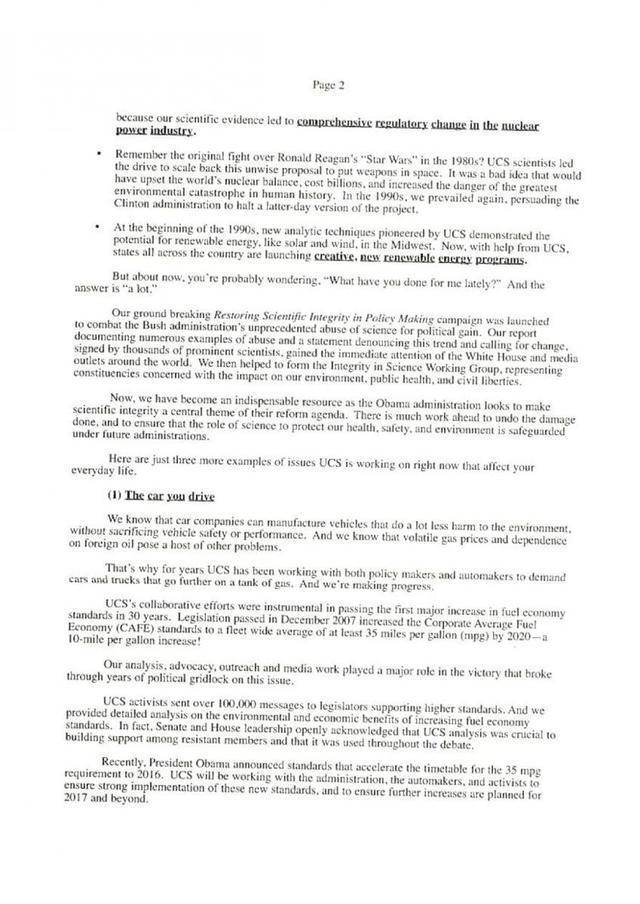 View original image
View original image
The confusion had been heightened by the organisation’s long-time in-house direct mail programme, which had alternately mailed appeals about individual national security and environmental issues with no evidence that they were connected to each other in any way.
Mal needed to resolve this confusion before he could write an effective fundraising package. He had to identify which theme would work best with donors. ‘We needed to do some fundamental testing to find the best approach, so at the outset we decided to test three different packages. One focused on the national security issues. The second package merged national security and the environment into a global perspective that took into account all threats to the planet, both environmental and security related. And finally we focused on the environment – but in a way that was somewhat similar to the second package.’
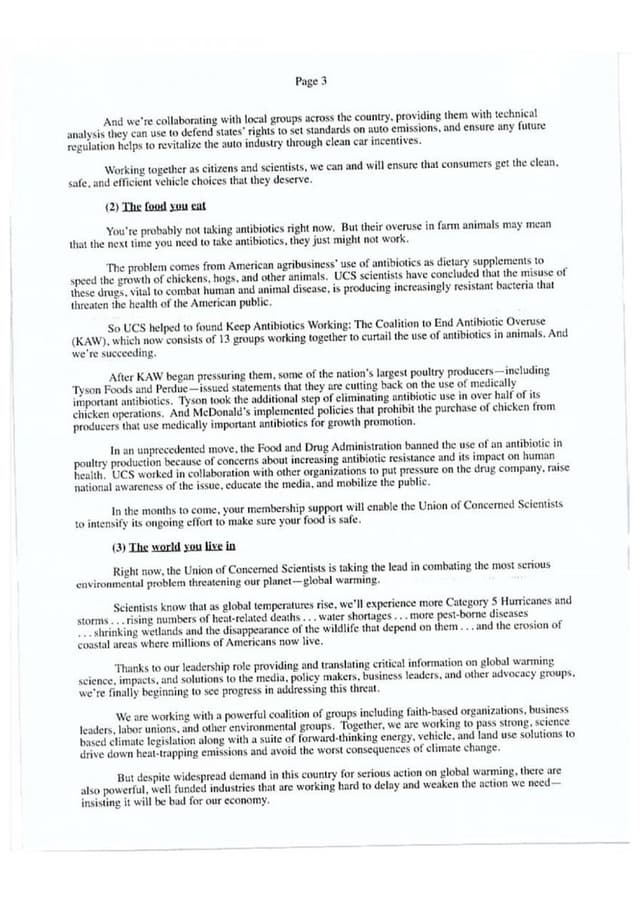 View original image
View original image
Creating an evergreen package
This was a very conscious effort to try and create an‘evergreen’ acquisition package – a long-lasting ‘control’ package, as Mal put it. ‘We wanted to create something that would not be tied to a specific case, project, or issue, but rather a package that would endure over the years. The danger of doing a case-based fundraising package is that you need to update it, to find new cases, and change the emphasis as the organisation’s story evolves. If you focus on the core of what the organisation does you have a better chance of it being timeless.’
Mal says he usually uses specific cases or issues in appeals sent to existing members or donors but more rarely for acquisition packages to identify new donors. ‘An acquisition package may focus on a certain general issue with the objective of engaging the recipient in the organisation to become a member or a donor who will be open to our further appeals. However, if we focus on a currently hot issue to recruit people as new members and don’t address that same issue next year, or the year after, we could have a much lower chance of getting those new members to renew their support.
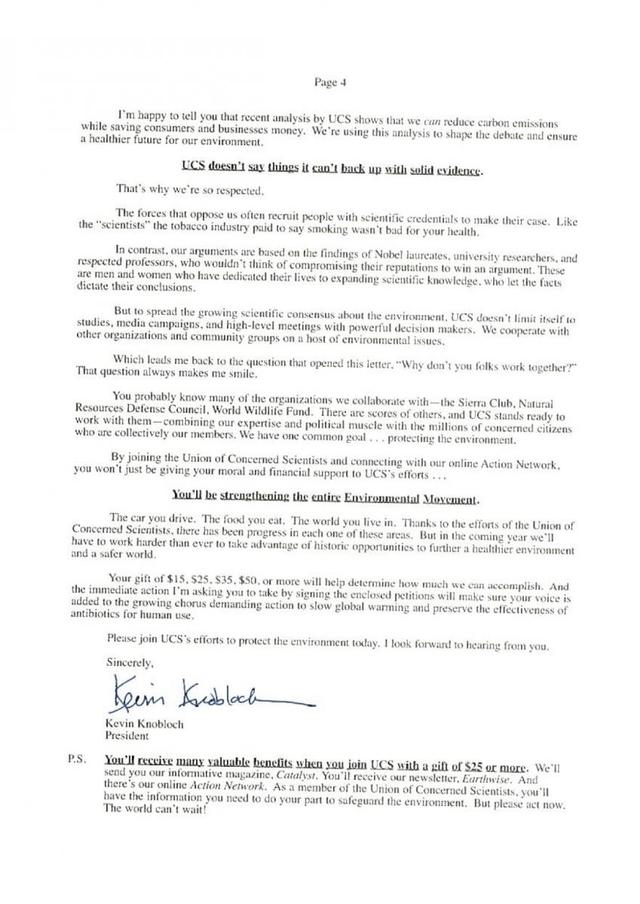 View original image
View original image
‘It’s the same principle when an international relief organisation appeals for emergency help in the face of famine in a corner of Africa, for example, or floods in Pakistan. They might bring in lots of new donors through such an appeal, but then they often have difficulty getting even a small percentage of those people to support them when they appeal on some other issue.’
Mal’s aim here is have a conversation with recipient – not deliver a single message. ‘The objective in direct mail fundraising is to initiate a dialogue with the reader. The more deeply you can engage her or him in that dialogue, the more likely it is that she will become a member or send a gift – whatever the ask might be – and be open to continuing the dialogue in the future.’
What happened?
The environmentally themed package was the most successful of the three. ‘It immediately became the control acquisition package for UCS and lasted in almost identical form for a decade’ says Mal. ‘When we first began working with UCS, it was a small organisation with about 25-30,000 active members. This package was one of the workhorses that helped to ultimately bring the membership up to more than 100,000.’ Even more significantly, he explains, the larger membership provided a solid foundation on which UCS could launch its first major donor programme – a programme that has yielded many millions of dollars in recent years.
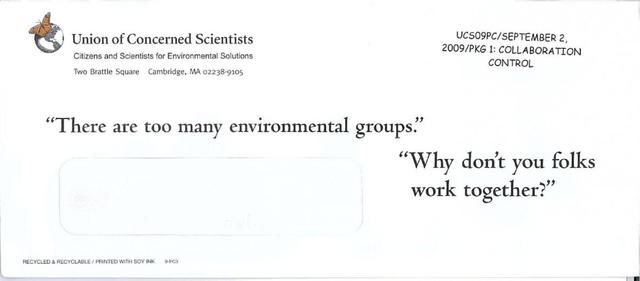 View original image
View original image
Vital research
At the outset, Mal wanted to find a clear way to approach the question of the organisation’s activist role on environmental issues. To find out how to position UCS, he spent hours talking to the organisation’s president and staff and studied the files to get an understanding of the core function of UCS.
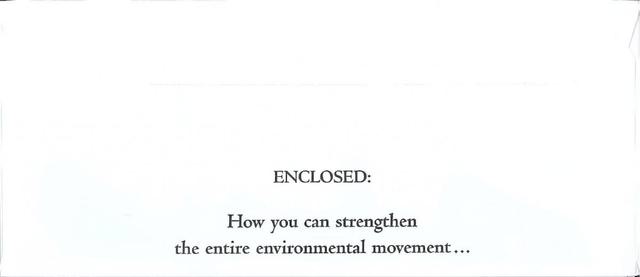 View original image
View original image
‘It became very clear to me that the major role that UCS played in the overall environmental movement was to provide critical research findings to other, larger organisations with bigger constituencies, and to collaborate with them on activist campaigns that would change national policy.’
Mal says that this was a revelation to him and indeed, to some degree, to UCS staff as well. ‘I think before we had always thought about UCS in terms of its own individual impact as an organisation – which was not inconsiderable. Indeed, on their own they had managed to change some important policies. But we now had a new way of looking at UCS, so I decided to turn this into a hook or theme of the package to bring people into the organisation, as I realised that what UCS did resonated with the feelings and concerns of most environmentalists.
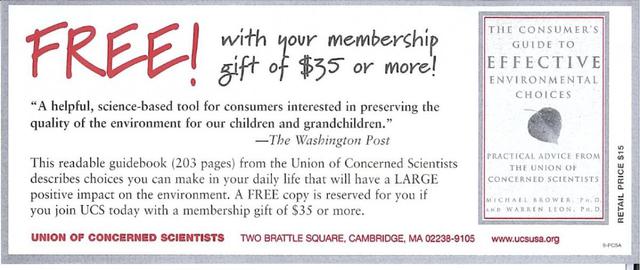 View original image
View original image
‘There is a plethora of environmental organisations in the United States, perhaps tens of thousands of organisations purporting to address some aspect of environmental issues. This splintering of effort is very inefficient and is a very common lament among members of the public who are concerned about the environment. If you talk to donors you’ll typically find that they support not one but five or 10 different nonprofit organisations, and most ask why don’t these guys pull together? Why is there such atomisation of effort?’
This theme of collaboration became the backbone of the package. Mal believes the letter’s success confirms that the theme definitely resonated with the public and that it was close enough to the essential truth of the organisation to be entirely credible and to be borne out year after year by the actions of the staff. When writing to donors you try and meet them where they are – if you can do that, you will have a powerful communication.
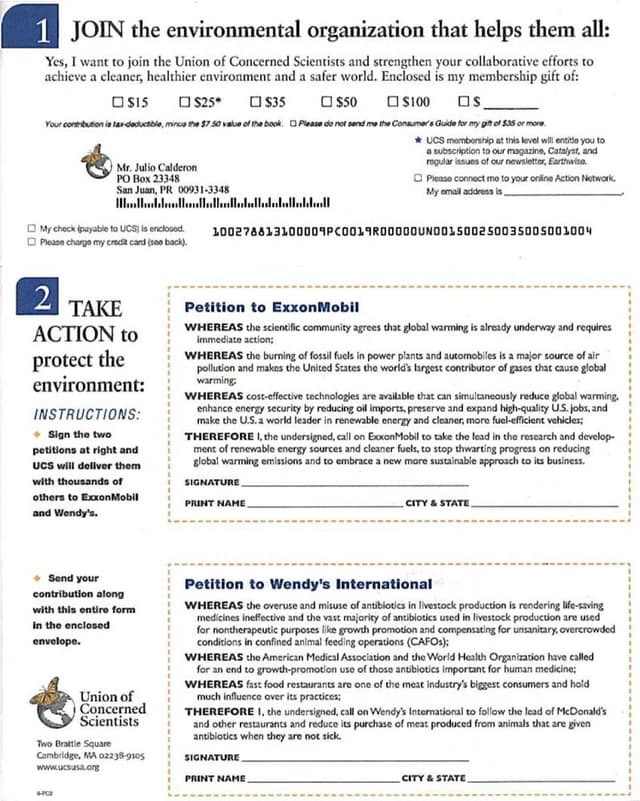 View original image
View original image
This echoes the idea of celebrated advertising writer and author Robert Collier from the USA, who wrote that ads should enter the conversation already going on in the prospect’s mind. Here, Mal was well positioned to do this because of his background research.
Some 12 years later, Mal still believes that collaboration is a key concern for donors to environmental organisations. ‘It is a phenomenon that’s present in other sectors of the nonprofit world, but it seems to have become most dramatically a matter of concern among environmental donors.’ Indeed, a recent Read Group research project in the UK found similar results. When asked if the current economic climate means that people have different expectations of charities, 37 per cent, the highest response rate to this question, responded that they thought charities should merge with other charities that do similar work.
(http://www.readgroupplc.com/charities-and-not-for-profit.html.)
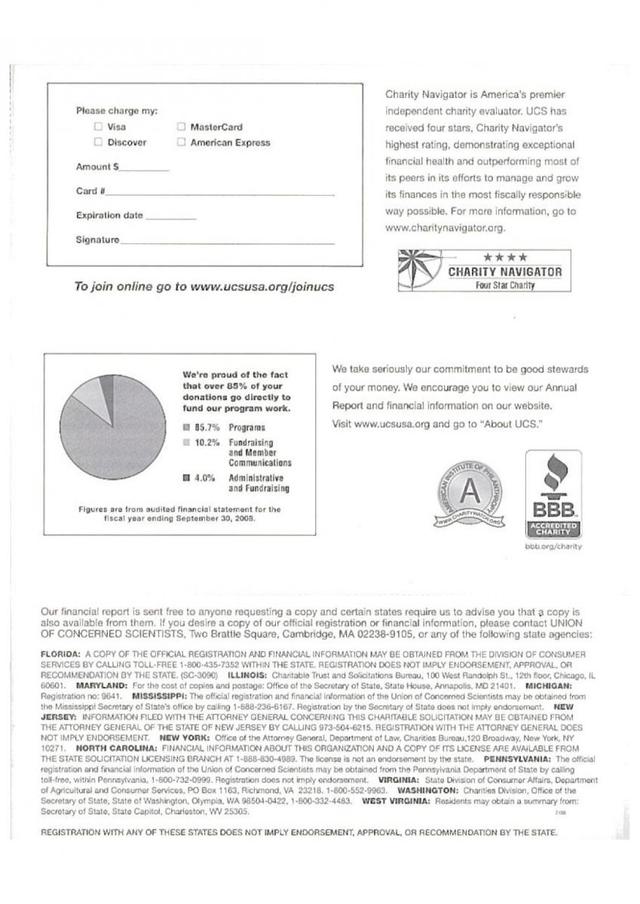 View original image
View original image
Envelope teaser
The following two-part teaser appears on the front of the carrier envelope:
‘There are too many environmental groups!’
‘Why don’t you folks work together?’
When you look at the back of the outer envelope you will see that the theme of collaboration is explicitly raised there.
ENCLOSED:
How you can strengthen
the entire environmental movement?
Mal does not typically begin by writing a teaser. He usually waits until much later in the process before thinking about the envelope. ‘Usually whatever copy appears on the envelope, if any – and I frequently do not use teasers – comes after I’ve written the text and I know the major concerns I want to convey. But in this case the teaser fell into my lap as a result of this extensive research I’d conducted. So I began with the teaser. And I then followed one of my rules, which is: if you’re going to use a teaser, you’d better address it some way in the beginning of the letter.’
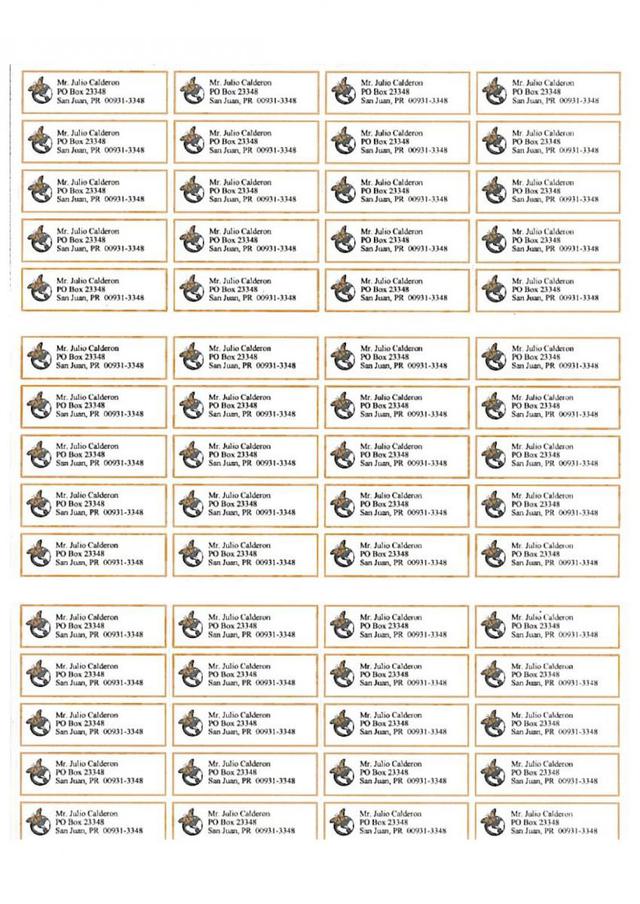 View original image
View original image
‘Why don’t you folks work together?’
The Johnson box repeats the question from the outer envelope. ‘I wanted to address the question right off the bat and not leave people hanging’ says Mal. ‘I wanted to highlight the connection between the lead sentence and the Johnson box – the question in the teaser.’
Dear Friend of the Environment,
Mal always looks for ways to personalise the salutation. ‘If I’m writing to people who I believe have a certain affiliation, I’ll try to incorporate that into the salutation. It’s much more powerful because it’s another element of identification with the donor. Here I made the salutation explicit, saying “Dear Friend of the Environment” rather than “Dear Friend.” This is clearly a letter addressed to people who care about the environment. We were sending this predominantly to people who were members of, or donors to, other environmental organisations, so we knew there was a good chance that people would consider themselves to be friends of the environment.’
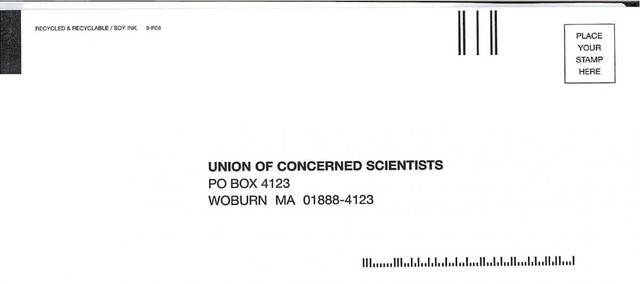 View original image
View original image
Fostering collaboration
Many people, maybe you, think the environmental movement consists of hundreds of organisations working for the same objectives, but not working together to achieve them. In some cases, that may be true. But here at the Union of Concerned Scientists, collaboration is a guiding principle.
The second paragraph again addresses the common view about the lack of collaboration while clearly stating that collaboration is a guiding principle of UCS. ‘There’s an implicit request to collaborate – if collaboration is important to you, why not collaborate with us?’ says Mal. ‘And the request is specifically tied to the fact that the person we’re addressing is indeed a friend of the environment, wants to assist the environmental movement as a whole, and is unsure how to do this because there are so many organisations that profess to work toward the same objectives. So we’re presenting UCS as a way to aid the entire environmental movement.’
That’s why I am writing you with this personal invitation.
‘It’s hard to refuse a personal invitation. This is an effort to convey a sense of the one-to-one connection between the signer of the letter, Kevin Knobloch, who later became the president, and the recipient of the letter.’
The Union of Concerned Scientists is a partnership of many of the nation’s leading scientists with tens of thousands of people like you and me. We combine unbiased scientific research with citizen action to protect the world you live in. And we’ve been engaged in advocacy around the environment and national security for 40 years – under eight different presidential administrations.
‘Partnership was the overarching concept that I used to pull together all of the activities of the organisation. It was a smaller organisation then, so we could suppose that the recipients wouldn’t necessarily know the big role that partnership played. And it was important to spell it out, which I did in more ways than one. Certainly by specifically highlighting it in the text of the letter.’
Reply devices
‘In my first meetings with the leadership of the Union of Concerned Scientists, I established the requirement that every direct mail package we created would include action and involvement devices. From a purely functional standpoint, we knew from long experience that action devices increase the response rate. There is a certain percentage of people who receive a package like this who will fill out the response device but won’t send any money, so they become prospects for future acquisition (rather good ones, actually). But the overall response rate usually will include a larger percentage of people who do send money, so that’s the functional side of it.
‘From a psychological standpoint, we wanted to convey the fact that you don’t have to be a participant in the grass-roots lobbying efforts of the organisation, but you can be if you want to, and there are many ways that you can.’
It’s time you heard the untold story about the Union of Concerned Scientists – and it’s a good time to join us. You can become a member of UCS for as little as $25.
This is the first time Mal asks the readers – softly – for money. He says he did not ask at the beginning of the letter because he wanted to answer the fundamental question that he posed on the outer envelope. ‘That required the first few paragraphs of the letter. I do at times state the ask at the very outset but in this case I wanted to bind the ask for money with an ask for active support as well.’
But it’s not just your financial support we need. We want you to get involved. You can do that by joining our action network.
Mal’s goal here is to get the reader involved. ‘Over the years we’ve worked with hundreds of activist organisations engaged in grass-roots lobbying, and this is an approach we frequently take with them. We knew many of the people that we were writing to here were activist environmentalists, not just pure donors. We regard that as the number one benefit to members of UCS.’
Mal says that thinking about donor benefits is the centrepiece of his work. ‘The fundamental question that a copywriter has to face is: to whom am I writing, and what am I offering that person?
‘It would be interesting to know how many people took action but didn’t pay or join. I’m sure that a certain number did. I have no idea what the numbers are. It’s common to preserve the names of those who return the action device but no money, and then to send them the very same package again shortly afterward. You tend to get a far above average rate of response the second time around.’
Mal focused a lot of attention on advocacy in this letter written more than 12 years ago. And recently in his e-newsletter, he again highlighted the importance of advocacy as a key means to stimulate engagement, something he sees as increasingly vital in today’s complex and competitive fundraising landscape.
‘With the continuing growth of email and the Internet as an inexpensive way to involve supporters, grass-roots advocacy efforts, or campaigning, are becoming an ever-more familiar way for charities to recruit new supporters. It’s become equally important as a means to broaden their relationships with people who already support them.
‘But it’s a mistake to think of advocacy as consisting exclusively of sending out email action alerts. There are far more meaningful ways for your donors and other supporters to take part in advocacy on your behalf. For example, they might print, sign, and mail actual letters – on real paper! Or make telephone calls. Or attend meetings or rallies or demonstrations… walk picket lines… join delegations of citizens to visit legislators… or even climb up the side of a high-rise to hang a banner. All this is advocacy – and those few people who choose one of these more active ways to support you are worth their weight in gold. They’re certainly worth paying a lot of attention to.’ (You can read the whole article here: http://malwarwicknews.com/2011/01/mal-warwicks-newsletter-january-2011/#...)
Mal believes that a fundraising letter can raise money and stimulate people to get involved in supporting the charity at the same time. ‘I don't claim to understand the psychology at work, but I suspect that people (at least in the USA) are jaded by so many requests for money and are looking for more meaningful ways to relate to the causes they want to support. Offering them a way to become engaged as members at the outset may convince them that their contributions are really going to work for a cause they care a lot about,’ he says.
I’ve enclosed two petitions to corporations whose business practices have a large impact on the environment and your health. Please sign and return them to us, and you’ll help pressure Exxon Mobil and Wendy’s [fast-food restaurants]to change how they operate, in order to curb two of the biggest threats to our health and the world today – global warming and the overuse of antibiotics in livestock production.
Here there are two paragraphs with two petitions about two corporations. Mal says: ‘There is a big reason to include involvement devices of this sort because it does set up an “us versus them” mentality, which is very attractive to activists.’
This first version of the letter mailed in 1999. It changed over time, focusing on the activities of different corporations. In this case, Exxon Mobil and Wendy’s were chosen because they were prominent adversaries in two of the leading projects that UCS was working on when this letter was sent out. ‘Over the years we changed the target companies,’ Mal says, ‘as the news headlines changed and as the focus of the organisation’s programme changed.”
Our corporate adversaries…
‘This makes the connection with the two previous paragraphs and is playing with the adversarial psychology – them and us.’
Writing for people who scan
…giving other environmental activists and our friends in Washington and across the nation the independent scientific evidence they need to make the case and win the day.
‘This sentence connects with the bold underlined sentences earlier in the letter’ says Mal. ‘It was entirely conscious and reflects other elements in my approach to writing fundraising letters. I try first to limit the number of passages in bold type on one page to at most, say, four. Second, I highlight those sentences that describe the benefits. Third, I try to tell the story in what has been called the “short dialogue” – the reader can get the entire story just by scanning the bits that are in bold type. But it’s not easy to do.’
Here are just three more examples of issues UCS is working on right now that affect your everyday life.
This is a tightly argued and reasoned letter largely free of emotion. The style reflected the personality of the scientists and other highly educated people to whom the letter was addressed. ‘I was trying to address concerns that people have in their daily lives about the car you drive, the food you eat. Interestingly enough, this has changed. This central section of the letter has evolved from the first version, in which I was talking about the air that you, the reader, breathe, the water you drink, and the food you eat, which is a little bit closer to the emotional concerns that are typically found in fundraising appeals. As they evolved over the years, those general references were replaced by information about more specific issues and activities.’
In other circumstances, Mal believes it’s important to have a strong emotional focus, touching on emotions throughout a letter. ‘I think in other letters that I’ve written you can see more emotional copy. But people certainly feel strongly about the food they eat. Our news reports are full of stories about poisons entering the food chain. These sections are structured: here’s the problem, here’s what we did, and here are the consequences.’
In the months to come, your membership support will enable the Union of Concerned Scientists to intensify its ongoing effort to make sure your food is safe’.
‘These words, or their equivalent, appear at the end of each of the three sections’ says Mal. ‘We also say: “working together we can and will”, again emphasising the importance of activist engagement. We’re saying “if you support and get involved, these are the kind of things you can get engaged in: things that matter”. I’ve used “you” repeatedly throughout. This is very deliberate. One of my litmus tests for a fundraising letter is to count the number of times “you” and “I” are used as opposed to “we” and plural forms of “you”.’
‘USC doesn’t say things it can’t back up with solid evidence’
That’s why we are so respected.
The forces that oppose us often recruit people with scientific credentials to make their case.
‘Here again the letter is tapping into and emphasising an underlying adversarial, them-versus-us relationship.’
Which leads me back to the question which opened this letter. Why don’t you folks work together? The question always makes me smile.
You probably know many of the organizations we collaborate with – the Sierra Club, Natural Resources Defense Council, World Wildlife Fund.
‘The letter goes on to mention some of the organisations UCS works with and says that there are many others with one common goal – again we’re reiterating the key ideas and themes of collaboration.’
Your gift of $15, $25, $35, $50, or more will help determine how much we can accomplish.
‘This is a soft ask that’s probably closer to the polite approach I might take if I were talking face to face with one of these people.’
PS As a member of the Union of Concerned Scientists you’ll have the information you need to do your part to safeguard the environment.
‘In the PS, we mention some of the benefits. The key sentence here is: “As a member of the Union of Concerned Scientists you’ll have the information you need to do your part to safeguard the environment.” That really does sum up the case for giving to the Union of Concerned Scientists.’
Free consumer guide
FREE! With your membership gift of $35 or more.
‘We also have these free name/address stickers, which I am not a fan of at all, but they’ve become a major feature of lots of big acquisition packages that are used in direct mail fundraising in the United States precisely because they do indeed increase the response rate.
There were no labels in the original package. However, one of the numerous tests over the years showed that response was demonstrably higher when address labels were added, so they remained a feature of the package throughout the remaining years.’
The ask array
In this letter it is: $15, $25, $35, $50, $100, and then an open-ended figure. ‘That’s fairly typical, although that too was tested many, many times. I don’t believe that when we began we offered a $15 entry-level gift, but I think it became clear through testing that response went up by including it.’
Matters of style and editing
Mal typically will do a couple of rounds of edits himself. He adds: ‘I should explain that the Union of Concerned Scientists is very concerned about maintaining credibility, making sure the facts are right. The staff has been trained to be absolutely ferocious in seeking out anything that’s misleading, much less inaccurate. So they went through many, many rounds of edits on the original version of this piece. We had to negotiate the use of some words and some phrases. Some of the arguments I was making had to be either eliminated or toned down. The result was, I think, still very strong, in part because I just doggedly insisted on making it strong.’
Many writers argue that the language in a letter should be simple and easily understood by the widest possible audience to get their message across. Here, there are a lot of multisyllabic words. Mal says it all depends upon the audience. ‘In truth this style probably is closer to my natural style than would be the case in many situations. The fact is we did indeed choose to write at a level of intellectual sophistication to appeal specifically to people who are better educated and more aware of environmental issues.’
Mal continues: ‘We knew from studying the membership of UCS that a substantial majority of the membership were scientists, including engineers and people with scientific training who are teaching science in secondary schools. But in any event it included people who had at least a basic scientific knowledge. If we count just the people with graduate degrees I’m sure it was the majority.
‘Layout and white space, single-sentence paragraphs, and limiting paragraphs to no more than two or three sentences – all those are very important. First of all, good designers will tell you that the white space is just as important as the space that’s filled, because it provides rest for the eye, and the eye does need rest. If you push the margins and include long, long paragraphs of text, you’ll find that readers stop reading pretty quickly.’
Mal points that he devotes special care to transitions to keep readers reading. ‘Partly it’s simply a matter of making the text flow. The transitions are critical, because I shift gear on many, many occasions in the course of this letter. But making that shift smooth, almost an automatic shift, is a key trick of the trade. I tend not to think about it consciously unless something just feels awkward when I read it aloud. Reading aloud is a really useful way to examine the transitions. If it feels awkward or if any sentence doesn’t feel like it’s natural coming out of my mouth, it needs to be changed.’
The keys to success
In retrospect, Mal thinks there are three key factors to why this package is so successful. ‘Firstly, we’re tapping into the concern about lack of collaboration’ he says. ‘Secondly, the psychological aspect of this is very important. We conjure up strong emotions by tapping into the adversarial idea of “them versus us”. And finally, we tap into the recipient’s desire to do something, to take action.’
After years of working with UCS, Mal believes that it is one of the most effective nonprofit organisations he has ever worked with. ‘UCS is a remarkable organisation. Indeed, that effectiveness was recognised some years back when the Union of Concerned Scientists was selected as one of a handful of nonprofits in the USA to receive spontaneous $1 million gifts from the John D and Catherine T MacArthur Foundation on its the twenty-fifth anniversary. It truly deserves to be supported.’


















